Successful of the calibration of the complete flighting model
The X-ray telescope MXT, one of the two instruments under French responsibility onboard the SVOM Chinese-French satellite payload, has just completed an important step in the project's progress, the calibration of the complete flying instrument. Three intensive weeks of work, spread over the months of October and November 2021, were necessary for the CNES and CEA teams, with the support of the IJCLab in Orsay, the University of Leicester and the MPE in Garching, to verify that its performance perfectly met the scientific specifications. This calibration, carried out at the MPE's Panter facility, took place during several phases, all of which were successfully completed. MXT is now ready to continue its adventure, the integration on the platform of the SVOM satellite in 2022, the launch on board the Long March 2C rocket in 2023 to then to accomplish with the other instruments of the project its mission of discovery gamma-ray bursts and the transient sky.

MXT at Panter
The Microchannel X-ray Telescope (MXT) is a focusing telescope sensitive in the X-ray range between 0.2 keV and 10 keV. It is one of the four instruments making up the payload of the SVOM (Space based multi-band astronomical Variable Object Monitor) satellite. The innovative MXT telescope will use for the first time in space a “Lobter Eye” optic based on the assembly of millions of leaded glass micropores. As for any scientific instrument, the calibration phase is an important, if not crucial, step in the evaluation process of its proper functioning and performance, requiring here a more particular attention for an original device design to work in space.

During October and November 2021, after an initial test campaign of the various sub-systems performed in 2020, the “End-to-End” testing of the complete flight model took place at Panter. Panter is a facility of the Max Planck Institut für Extraterrestrische Physik (MPE), located near Munich in Germany and unique in Europe. This leading facility allows the characterization of optics and telescopes in the X-ray range (0.2-10 keV). With a length of 132 m, a distance that allows a good reproduction of the flux coming from celestial sources (very low divergence of the beam), this installation has perfectly fulfilled its role. Panter's track record already includes calibrations of missions such as EXOSAT, BeppoSAX, JET-X, ABRIXAS, XMM-Newton, Swift, Suzaku, HXMT-Insight, eROSITA and now MXT.
An adapted calibration plan
This campaign, that involved teams from CNES and CEA (with the support colleagues of the IJCLab of Orsay, the University of Leicester and the MPE), allowed the final validation of the thermal and electrical configuration of the telescope, the mechanical alignments, but above all the final measurement of the scientific performances of MXT (including the real-time localization by the embedded software).
The characteristics of the spread function (composed by a central peak and a cross structure), their variations as a function of energy and the position on the field of view have been measured. The line of sight of the telescope was also measured, which will allow the most accurate integration on the SVOM satellite platform and the effective area of the telescope was precisely determined.

In parallel, measurements of the spectroscopic response of the detection plane have been performed using the direct flux (proportion of photons that have not interacted with the optics), covering the whole energy range of MXT. The last days of tests were used to characterize the response of the telescope to visible and infrared light (using lasers) to simulate the influence of “stray light”, i.e. the light reflected by the Earth's atmosphere which, once the MXT camera is placed in orbit, could disturb the MXT measurements by constituting a source of low energy pollution.
This calibration mobilized the MXT teams, including a group of technicians, engineers and researchers from Irfu and DAp, and that for several weeks. Detailed analyses are in progress, but we can already affirm that the MXT team will deliver to the SVOM mission, after several years of work, a healthy and well characterized telescope!
Contacts CEA: Diego Götz, Aline Meuris
See also :
The SVOM site
The site of the PANTER facility at MPE Garching
Written by Diego Götz, Aline Meuris, Christian Gouiffès


